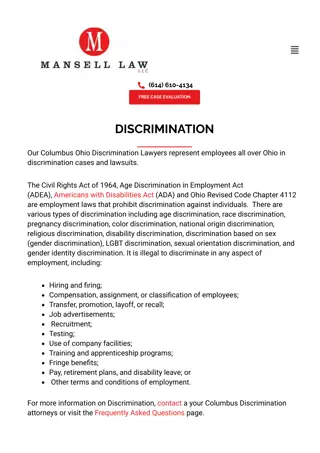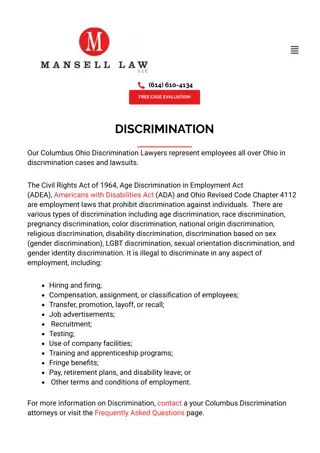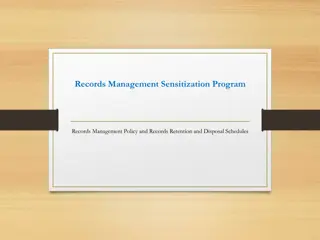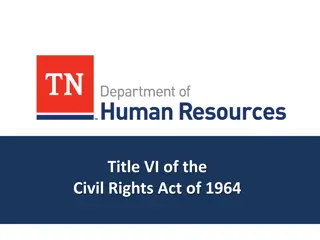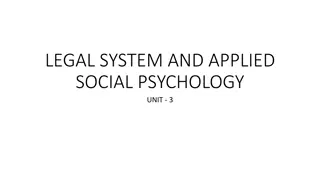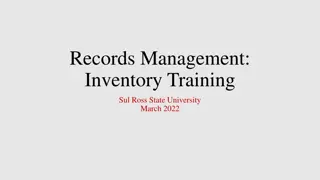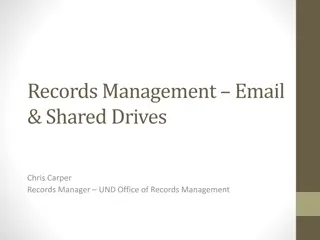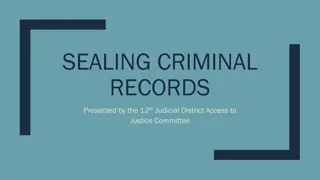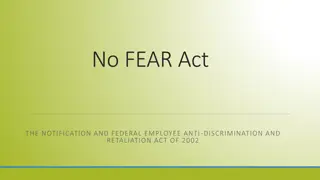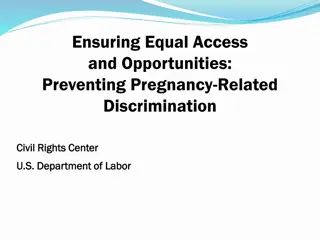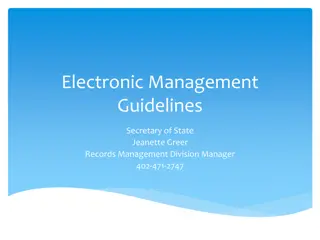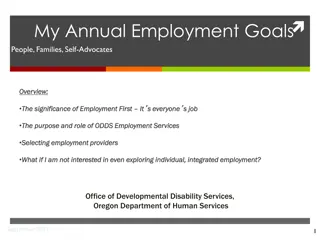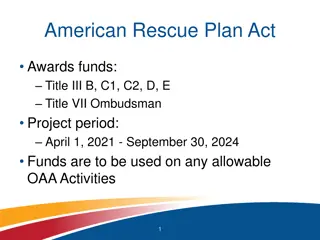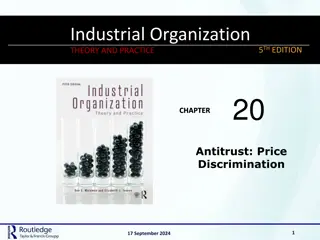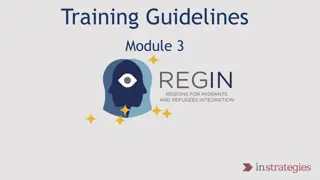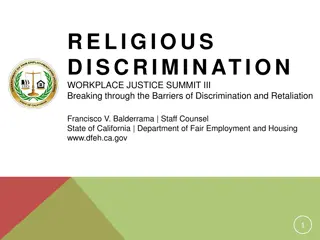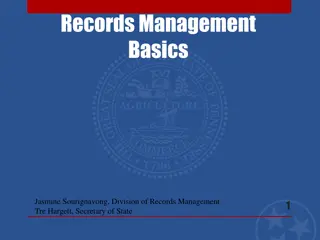Understanding Title VII and Criminal Records in Employment Discrimination Cases
This presentation delves into the intersection of Title VII and criminal records in employment discrimination cases. It covers the lack of specific protections for individuals with criminal records under Title VII, the implications of disparate impact cases, and the development of standards in the context of criminal discrimination.
Download Presentation

Please find below an Image/Link to download the presentation.
The content on the website is provided AS IS for your information and personal use only. It may not be sold, licensed, or shared on other websites without obtaining consent from the author. Download presentation by click this link. If you encounter any issues during the download, it is possible that the publisher has removed the file from their server.
E N D
Presentation Transcript
Litigating Criminal Record Cases Against Employers May 3,2023 Sharon Dietrich Litigation Director sdietrich@clsphila.org Ossai Miazad Partner om@outtengolden.com
Sources of Claims Title VII Local Fair Chance Laws Fair Credit Reporting Act
Overview of Title VII & Criminal Records Title VII protects against employment discrimination to a protected class: It shall be an unlawful employment practice for an employer (1) to fail or refuse to hire or to discharge any individual, or otherwise to discriminate against any individual with respect to his compensation, terms, conditions, or privileges of employment, because of such individual s race, color, religion, sex or national origin[.] 42 U.S.C. 2000e-2(a)(1). Title VII has no specific protections for persons with criminalrecords. However, employers are subject to liability if their policy or practice has a disparate impact on individuals in a protected class. An unlawful employment practice based on disparate impact is established under this subchapter only if (i) A complaining party demonstrates that a respondent uses a particular employment practice that causes a disparate impact on the basis of race, color, religion, sex, or national origin and the respondent fails to demonstrate that the challenged practice is job related for the position in question and consistent with business necessity[.] 42 U.S.C. 2000e-2(k)(1)(a). No intent is required to prove your case.
The Three Phases of a Disparate The Three Steps to a Disparate ImpactCase ImpactCase
Development of Title VII in Criminal DiscriminationContext One year after Griggs v. Duke Power Co., 401 U.S. 424(1971): El provided a more tailoredbusiness necessitystandard: Green clarified businessnecessity in a case challenging an employer s refusal to employ persons withconvictions: Even an employer s bright-line policy could be legal if it accurately distinguish[es] between applicants that pose an acceptable level of risk and those that do not. El v. Southeastern Pennsylvania Transportation Authority, 479 F.3d 232 (3d Cir. 2007). A facially neutral questionnaire askingapplicants to disclose arrests operated to bar employment to Black applicants in far greater proportion than to white applicants . Gregory v. Litton Sys., Inc., 472 F.2d 631 (9th Cir. 1972) We cannot conceive of any business necessity that would automatically place every individual convicted of any offense, except a minor traffic offense, in the permanent ranks of the unemployed. Green v. Missouri Pacific Railroad Company, 523 F.2d 1290 (8th Cir. 1975: The case also criticized the then EEOC enforcement guidelines as failing to substantively analyze Title VII, and thus not entitled to great deference. An employer s invocation of business necessity is tested by examining: (1) the nature and gravity of the offense or conduct; (2) the time elapsed since the offense or conduct and/or completion of the sentence; and (3) the nature of the job sought or held. Green v. Missouri Pacific Railroad Company, 549 F.2d 1158 (8th Cir.1977)
The EEOCs2012 EnforcementGuidance The EEOC had provided general guidance on selecting employees and specific guidance on use of criminal records, but the 2012 Enforcement Guidance is the EEOC s most recent statement on the issue. Adopts the GreenFactors. Substantially more detailed than guidelines criticized by El v. SEPTA. Available at http://www.eeoc.gov/laws/guidance/upload/arrest_conviction. pdf
The EEOC Guidance AddedContext Emphasizedthat: The fact of an arrest does not establish criminal conduct has occurred and that [a]rrests are not proof of criminalconduct. As a best practice , employers should not ask about convictions on job applications and that, if and when they make such inquiries, the inquiries be limited to convictions for which exclusion would be job related for the position in question and consistent with business necessity . Employers will consistently meet job related and consistent with business necessity defense in twocircumstances: Employer validates criminal conduct search according to Uniform Guidelines on Employee Section Procedures standards; or Employer develops a targeted screen that at least considers: (1) nature of the crime; (2) time elapsed; and (3) the nature of the job (i.e. the three Green factors) and provides an opportunity for individualized assessment for people excluded by the screen to see if the policy as applied is job related and consistent with business necessity. What should the individualized assessment consist of? Notice to individuals that they were screened out because of criminal convictions; Opportunity to demonstrate exclusion should not apply based on individuals particular circumstances; Employer review of additional information provided by employer and consideration of whether that information warrants an exception; and Note: individualized assessment is not necessarily require[d] . . . In all circumstances provided that the screen, based on the Green factors is narrowly tailored to identify criminal conduct with a demonstrably tight nexus to the position in question.
RecentCases I Challenge to a no felony hiring policy. Challenged U.S. Census s refusal to hire individuals with criminal records who could not produce official court records within 30 days. Certified FRCP 23(b)(2) class of Black and Latino applicants. See Houser v. Pritzker, 28 F. Supp. 3d 222 (S.D.N.Y. 2014) Settlement approved on September 20, 2016. See Gonzalez v. Pritzker, No. 10 Civ. 3105, 2016 WL 5395905 (S.D.N.Y. Sept. 20, 2016) Challenge to overly strict background check policy that fails to consider rehabilitation and other mitigating circumstances. Complaint cited to national statistics, as evidence to support their claims that Blacks are arrested and incarcerated at higher rates in the national population and thus a strict criminal history screen likely to have disparate impact. Heavy reliance of screening out applicants based on failure to fully disclose records on application. Filed in July 2021, almost two years of discovery disputes, most recently appointment of a private discovery referee and the parties will have to share the cost. District Court dismissed for failure to state a claim, holding that the statistics failed to show a relationship between the pool of NTT applicants who are white versus African American and their respective rates of felony convictions. Still fighting it out . Mandala v. NTT Data (N.D.N.Y.) Houser v. Pritzker, No. 14 Civ. 1289(S.D.N.Y.) Ramos v. Walmart 2:21-cv-13827 (D NJ)
Recent Settlements DHL Supply Chain Nationwide Title VII Uber Eats NYC Fair Chance Act Fresh Direct NYC and NYS Human Rights Laws
Some Things to Keep In Mind Explore local fair chance / ban box claims to bring in conjunction with a Title VII claim or instead. Investigation & coalition building before filing a lawsuit Careful crafting of class definition & articulation of challenged policy Be prepared for battle of the experts The failure to disclose defense
Greatest Impact Depending on the circumstance it could be a demand letter, filing with an administrative agency, filing in state or federal court. Requires careful investigation of facts, other impacted individuals, legal claims and jurisdictional issues. Collaboration and crowd sourcing expertise is key. Ossai Miazad om@outtengolden.com 646-825-9817
An intake should focus on what happened when Violations can turn on when a check was run or notice of an adverse actionoccurred. The federal Fair Credit Reporting Act ( FCRA ) requiresthat: o Before a background check, the employer must obtain from the applicant a clear and conspicuous disclose that is in writing and consists solely of the disclosure that a consumer report may be obtained for employment purposes, as well as a written authorization by the applicant (15 U.S.C. 1681b(b)(2)). o Before an adverse action is taken, the employer must provide the applicantwith a copy of the consumer report and a statement of rights under the FCRA, and time to dispute the contents of the report (15 U.S.C. . 1681b(b)(3)). Investigation Afterthe Denial Accordingly, a clear timeline iscrucial. Think about both procedural and substantive violations: A timing violation versus an unjustified denial because of a criminalrecord. Intakes After the Denial of Employment of Employment Think about how the Green factors apply to the applicant s specific conviction and ask questionsaccordingly. Think about whether the denial was reflective of a broad policy or appears to be an isolatederror: For substantive denials of employment, the potential violation can turn on how the employer analyses the conviction (e.g. is it a blanket ban?). If allowed to do so, and have time, request the client s full criminal background: Can catch errors in what is beingreported. Can understand clients complete history. Depending on the position, research may be required to determine whether the employer has a legal basis to denyemployment. But be careful about employer arguments that overstate the categories of convictions for which they are legally allowed to denyemployment.





